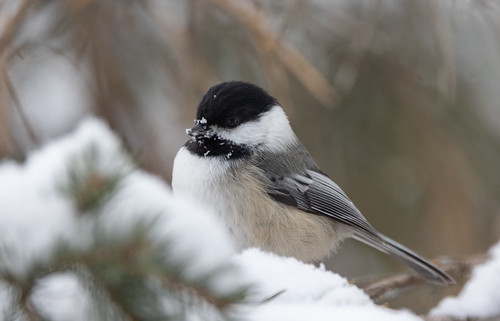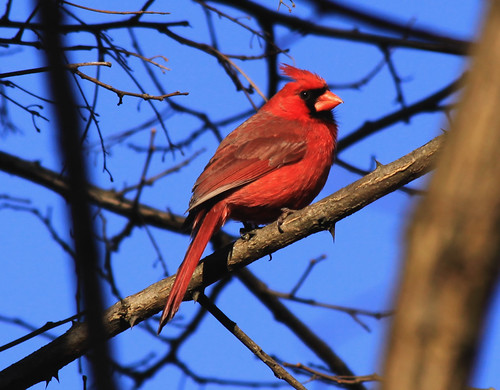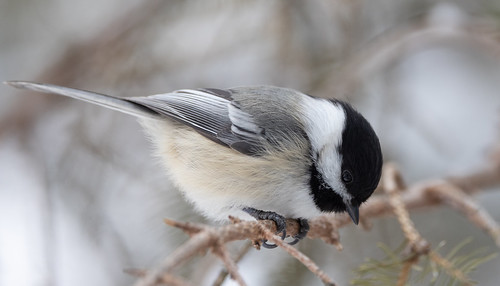Every morning when I go out to add food to the feeders, I’m hearing a wonderfully welcome sound—my neighborhood chickadees are singing their lovely Hey, sweetie! song, a promise that come spring, these beloved little guys will be doing what needs to be done to ensure the production of new baby chickadees. That clear, whistled song is produced mostly by males, though females are known to sing, too.
Researchers describe the song as a simple Fee bee, the first note higher than the second, and the second with a very short amplitude break in the middle, audible at close range, that makes it sound more like fee bee-bee. (You can hear it at this link.) My hearing is not very good, but I can hear that break almost all the time, even when the chickadees are pretty far away.
The Eastern Phoebe’s raspy song is also described as fee bee, fee bee-bee, but it sounds entirely different (listen here), confusing a lot of people. So instead of using that to describe chickadee songs, I use a different mnemonic, Hey, sweetie!, which serves a double purpose, suggesting one of the purposes of the song, to attract a mate and keep that pair bond strong.
Bird songs, including those of chickadees, usually do double duty, also announcing that the singer owns and is willing and able to defend a territory. The male chickadees who rank higher in the flock hierarchy sing more than lower-ranking birds do. The singing right now, in the dead of winter, helps solidify flock rankings and pair bonds without disrupting flocking behavior. Those of us who feed birds get to hear more songs than people living farther from feeders—the chickadees who visit high-quality feeding stations first thing in the morning sing more frequently than chickadees who have to work harder for their breakfast.
Cardinals are singing now, too. At least some chickadees and cardinals were singing a bit back in December, but as days lengthen, giving them more hours to find food each day, they can spend more time on singing and other things. Male cardinals sing year-round, most frequently in the Midwest from late February through July. Female cardinals have a much shorter singing period, more closely coinciding with nesting. Even then, they sing about a fifth as often as males or less.
Female cardinals have pretty much the same repertoires as males but their songs can be longer with more syllable types. That greater complexity probably has to do with what they’re communicating to the male regarding her needs during incubation and feeding young. Song exchanges between incubating or brooding females and their mates appear to coordinate male feeding visits to the nest. Females also sing in territorial defense of their nest. Males “countersing” with neighboring males as well as with their mates. Before nesting, males and females match each other’s song types more than males countersinging with other males do.
Intriguingly, there are differences in the singing styles of the familiar cardinals in Canada and most of the United States and the cardinals in Mexico and parts of Arizona. Those of us who pay attention to cardinals may notice that the males in Southeastern Arizona have longer crests, are a slightly different shade of red, and have slightly less black on their faces than cardinals elsewhere in the US and Canada. Their songs are also slightly different. (You can hear both the common Northern Cardinal and the long-crested cardinal on the All About Birds cardinal page here.) Ornithologists are considering splitting cardinals into as many as six species, four of which are found exclusively in Mexico; more research into the vocalizations and genetics of the six types will determine whether any or all of them are truly separate or not.
Chickadee and cardinal songs are so musical that we can’t help but recognize them as true songs. Woodpeckers are drumming right now, which serves as their song, too. Like chickadees and cardinals, they won’t be starting to nest for several weeks, but drumming serves pretty much the same purposes as more musical songs.
White-breasted Nuthatches are also singing, but people don’t necessarily notice the differences between their day-to-day cranky yank! notes and their longer song, given exclusively by males, for pretty much the same purposes as chickadee and cardinal songs. You can listen to their calls and songs here.
Nuthatches stay in pairs through the winter, which is apparently more beneficial to the males than the females. Both benefit from a nearby extra pair of eyes searching out hawks, shrikes, and other dangers, but whenever a female comes upon a good food source, her mate chases her off to eat first. Fortunately, nuthatches eat like chickadees, carrying off a morsel to eat elsewhere, so she returns to a feeder as soon as he flies away.
Most of the other birds we’re hearing right now are making calls rather than songs. Juncos won't start making their trills until March and April. The handful of robins that overwinter up here will start singing around the time average day-night temperatures reach 37º F or so. Redpolls and other finches make plenty of twittering calls, but those don't count as songs.
February is the shortest month if you’re simply looking at the number of days but by far the longest when we're hungry for spring. Fortunately, the sweetness and warmth of chickadee and cardinal songs touch our hearts as only the most exquisite valentine can do.










